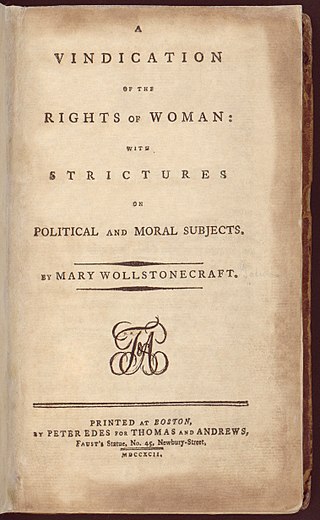
A Vindication of the Rights of Woman: with Strictures on Political and Moral Subjects (1792), written by British philosopher and women's rights advocate Mary Wollstonecraft (1759–1797), is one of the earliest works of feminist philosophy. In it, Wollstonecraft responds to those educational and political theorists of the eighteenth century who did not believe women should receive a rational education. She argues that women ought to have an education commensurate with their position in society, claiming that women are essential to the nation because they educate its children and because they could be "companions" to their husbands, rather than mere wives. Instead of viewing women as ornaments to society or property to be traded in marriage, Wollstonecraft maintains that they are human beings deserving of the same fundamental rights as men.

Jane Austen was an English novelist known primarily for her six novels, which implicitly interpret, critique, and comment upon the British landed gentry at the end of the 18th century. Austen's plots often explore the dependence of women on marriage for the pursuit of favourable social standing and economic security. Her works are an implicit critique of the novels of sensibility of the second half of the 18th century and are part of the transition to 19th-century literary realism. Her deft use of social commentary, realism and biting irony have earned her acclaim among critics and scholars.
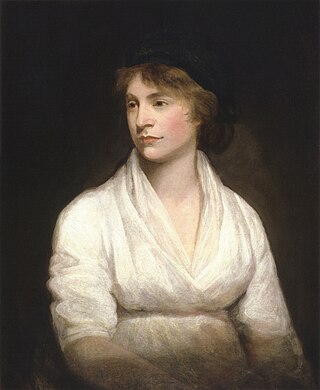
Mary Wollstonecraft was a British writer, philosopher, and advocate of women's rights. Until the late 20th century, Wollstonecraft's life, which encompassed several unconventional personal relationships at the time, received more attention than her writing. Today Wollstonecraft is regarded as one of the founding feminist philosophers, and feminists often cite both her life and her works as important influences.
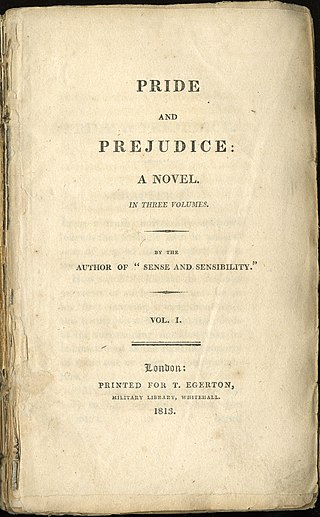
Pride and Prejudice is an 1813 novel of manners by English author Jane Austen. The novel follows the character development of Elizabeth Bennet, the protagonist of the book, who learns about the repercussions of hasty judgments and comes to appreciate the difference between superficial goodness and actual goodness.

Northanger Abbey is a coming-of-age novel and a satire of Gothic novels written by the English author Jane Austen. Northanger Abbey was completed in 1803, the first of Austen's novels completed in full, but was published posthumously in 1817 with Persuasion. The story concerns Catherine Morland, the naïve young protagonist, and her journey to a better understanding of herself and of the world around her. How Catherine views the world has been distorted by her fondness for Gothic novels and an active imagination.
The Beautifull Cassandra [sic] is a short novel from Jane Austen's juvenilia. It is a parody of the melodramatic, sentimental and picaresque novels of the time, and tells the story of a young woman who sets off into the world to make her fortune.

Cassandra Elizabeth Austen was an amateur English watercolourist and the elder sister of Jane Austen. The letters between her and Jane form a substantial foundation to scholarly understanding of the life of the novelist.

The reception history of Jane Austen follows a path from modest fame to wild popularity. Jane Austen (1775–1817), the author of such works as Pride and Prejudice (1813) and Emma (1815), has become one of the best-known and most widely read novelists in the English language. Her novels are the subject of intense scholarly study and the centre of a diverse fan culture.
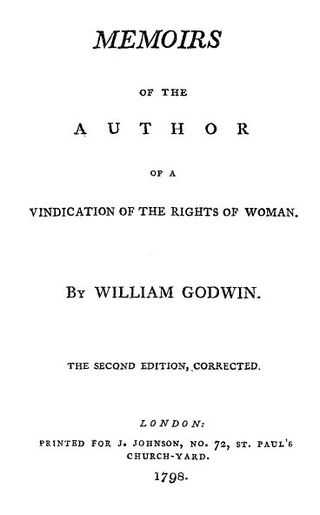
Memoirs of the Author of A Vindication of the Rights of Woman (1798) is William Godwin's biography of his late wife Mary Wollstonecraft. Rarely published in the nineteenth century and sparingly even today, Memoirs is most often viewed as a source for information on Wollstonecraft. However, with the rise of interest in biography and autobiography as important genres in and of themselves, scholars are increasingly studying it for its own sake.

Jane Austen lived her entire life as part of a family located socially and economically on the lower fringes of the English gentry. The Rev. George Austen and Cassandra Leigh, Jane Austen's parents, lived in Steventon, Hampshire, where Rev. Austen was the rector of the Anglican parish from 1765 until 1801. Jane Austen's immediate family was large and close-knit. She had six brothers—James, George, Charles, Francis, Henry, and Edward—and a beloved older sister, Cassandra. Austen's brother Edward was adopted by Thomas and Elizabeth Knight and eventually inherited their estates at Godmersham, Kent, and Chawton, Hampshire. In 1801, Rev. Austen retired from the ministry and moved his family to Bath, Somerset. He died in 1805 and for the next four years, Jane, Cassandra, and their mother lived first in rented quarters and then in Southampton where they shared a house with Frank Austen's family. During these unsettled years, they spent much time visiting various branches of the family. In 1809, Jane, Cassandra, and their mother moved permanently into a large "cottage" in Chawton village that was part of Edward's nearby estate. Austen lived at Chawton until she moved to Winchester for medical treatment shortly before her death in 1817.

A Memoir of Jane Austen is a biography of the novelist Jane Austen (1775–1817) published in 1869 by her nephew James Edward Austen-Leigh. A second edition was published in 1871 which included previously unpublished Jane Austen writings. A family project, the biography was written by James Edward Austen-Leigh but owed much to the recollections of Jane Austen's many relatives. However, it was the decisions of her sister, Cassandra Austen, to destroy many of Jane's letters after her death that shaped the material available for the biography.

Georgian society in Jane Austen's novels is the ever-present background of her work, the world in which all her characters are set. Entirely situated during the reign of George III, the novels of Jane Austen describe their characters' everyday lives, joys, sorrows, and loves, providing insight into the period.
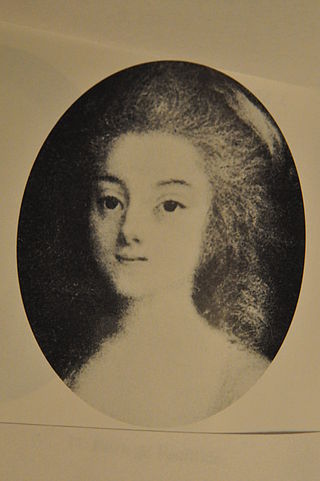
Eliza Capot, Comtesse de Feuillide was the cousin, and later sister-in-law, of novelist Jane Austen. She is believed to have been the inspiration for a number of Austen's works, such as Love and Freindship, Henry and Eliza, and Lady Susan. She may have also been the model from whom the character of Mary Crawford is derived.
Juvenilia Press is an international non-profit research and pedagogic press based in the School of Arts and Media at the University of New South Wales. The press undertakes to provide undergraduate and post-graduate students with hands-on experience of textual transmission under the guidance of an academic supervisor. The scholarly volumes published by the press are works from the genre of literary juvenilia—the early works of known writers—and are printed in a format that includes a preface, introduction, note on the text, end notes, textual and contextual appendices, and illustrations.
Robert William Chapman, usually known in print as R. W. Chapman, was a British scholar, book collector and editor of the works of Samuel Johnson and Jane Austen.

Edward Austen Knight was the third eldest brother of Jane Austen, and provided her with the use of a cottage in Chawton where she lived for the last years of her life. He was also High Sheriff of Kent in 1801.
Deirdre Le Faye was an English writer and literary critic.
Self-Control is a novel by the Scottish novelist Mary Brunton, published in 1811. The novel, which had some success in its own time, tells a rocambolesque tale, which inspired Jane Austen when she wrote her Plan of a Novel. Part of the author's intention in writing the work was to show "the power of the religious principle in bestowing self-command", while rebutting the idea that a reformed rake makes the best husband.
Anna Austen Lefroy (1793-1872) was the niece of Jane Austen by her eldest brother James Austen, and a contributor to her life-history via the so-called Lefroy MS.

James Austen was an English clergyman, best known for being the eldest brother of celebrated novelist Jane Austen. His father George Austen's living had been in Steventon, Hampshire, and James succeeded him in this position, in 1801.















